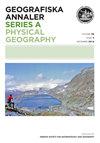Applications of glacial geomorphological and lichenometric studies for reconstructing the Late Holocene glacial history of the Hoksar valley, Kashmir Himalaya, India
IF 1.8
4区 地球科学
Q3 GEOGRAPHY, PHYSICAL
Geografiska Annaler Series A-Physical Geography
Pub Date : 2020-09-25
DOI:10.1080/04353676.2020.1822001
引用次数: 4
Abstract
ABSTRACT In this study, the lichenometry studies of the Hoksar Glacier valley in Kashmir Himalaya, India supported by the extensive ground- and remote sensing-based glacial geomorphological mapping enabled the identification of the six episodes of glacier advances in the valley. Field-based geomorphologic evidence suggests that the glacial episode 1 (GEI) experienced the most extensive glaciation in the Hoksar valley extending ∼1 km down the valley (altitude 3565 m) from the current snout position of the Hoksar Glacier (altitude 3680m). Lichenometric dating of the moraines suggests that the GE1 episode is chronologically the oldest (∼480 ± 25 years) and GE6 episode the youngest (∼245 ± 10 years). The mean equilibrium line altitude (ELA) during the GE1 episode was calculated as 3755 ± 4 m compared to the observed present ELA position of 4060 ± 5 m, an upward shift of 305 m observed during the period. The spatio-temporal changes of the Hoksar Glacier during different episodes of the glacier advances until 2018 showed that the glacier area has shrunk from ∼212 ha during the GE1 to 100 ha at present losing an area of 112 ha (52%) during the period mainly as a result of the recent climate change. The recent observed glacier recession (1980–2018) is much higher (11 000 m2 a−1) compared to the past recession (1300 m2 a−1). The study provides valuable insights about the glacier recession in the Kashmir Himalayan region during the Late Holocene where knowledge about the past glacial history on a regional scale is generally poorly investigated.冰川地貌和地衣测量学研究在重建印度克什米尔-喜马拉雅地区Hoksar河谷晚全新世冰川历史中的应用
在广泛的基于地面和遥感的冰川地貌测绘的支持下,对印度克什米尔喜马拉雅地区的Hoksar冰川谷进行了地衣测量研究,从而确定了该山谷的6期冰川推进。基于野外的地形学证据表明,冰川时期1 (GEI)经历了Hoksar山谷最广泛的冰川作用,从目前的Hoksar冰川口位置(海拔3680m)向下延伸约1公里(海拔3565 m)。冰碛物的地衣测年表明,GE1期在年代上最古老(~ 480±25年),GE6期最年轻(~ 245±10年)。GE1期间平均平衡线高度(ELA)为3755±4 m,比目前观测到的平均平衡线高度(ELA)为4060±5 m,上升了305 m。截至2018年,不同冰川推进时期Hoksar冰川的时空变化表明,冰川面积已从GE1期间的~ 212 ha缩小到目前的100 ha,其中112 ha(52%)的面积在此期间主要是由于最近的气候变化。最近观测到的冰川退缩(1980-2018)比过去的退缩(1300 m2 a−1)要高得多(11 000 m2 a−1)。该研究为克什米尔喜马拉雅地区晚全新世冰川消退提供了有价值的见解,该地区对区域尺度上过去冰川历史的研究通常很少。
本文章由计算机程序翻译,如有差异,请以英文原文为准。
求助全文
约1分钟内获得全文
求助全文
来源期刊
CiteScore
3.60
自引率
0.00%
发文量
12
审稿时长
>12 weeks
期刊介绍:
Geografiska Annaler: Series A, Physical Geography publishes original research in the field of Physical Geography with special emphasis on cold regions/high latitude, high altitude processes, landforms and environmental change, past, present and future.
The journal primarily promotes dissemination of regular research by publishing research-based articles. The journal also publishes thematic issues where collections of articles around a specific themes are gathered. Such themes are determined by the Editors upon request. Finally the journal wishes to promote knowledge and understanding of topics in Physical Geography, their origin, development and current standing through invited review articles.

 求助内容:
求助内容: 应助结果提醒方式:
应助结果提醒方式:


